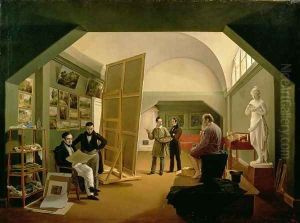Kapiton Alekseevich Zelentsov Paintings
Kapiton Alekseevich Zelentsov was a Russian painter born in 1790 in the Russian Empire. His life and career were profoundly intertwined with the cultural and artistic movements of early 19th-century Russia, a period marked by a flowering of Russian arts and literature. Zelentsov's body of work is distinguished by its diverse range, encompassing landscape painting, portraiture, and historical scenes, reflecting the broader tendencies of Russian art of the time towards romanticism and realism.
Educated at the Imperial Academy of Arts in Saint Petersburg, Zelentsov was part of a generation of Russian artists who sought to express the national identity and the unique landscapes of Russia through their art. He was deeply influenced by his travels across the Russian Empire, where he sketched and painted the vast and varied landscapes, from the bustling cities to the serene countryside. His works are characterized by their meticulous attention to detail, vibrant color palette, and the ability to capture the mood and atmosphere of the places he depicted.
Throughout his career, Zelentsov enjoyed the patronage of several important figures in Russian society, which allowed him to work on a variety of projects, including commissions for the Russian imperial family. His portraits often depicted members of the Russian nobility and intelligentsia, capturing the nuances of their personalities and the intricacies of their attire with precision and sensitivity.
Zelentsov's contributions to Russian art were not limited to his own creations. He was also a respected teacher and mentor to younger artists, imparting his knowledge and passion for art to the next generation. His legacy is preserved in the collections of major Russian museums, where his works continue to be admired for their beauty and historical value.
Kapiton Alekseevich Zelentsov passed away in 1845, leaving behind a rich oeuvre that offers a window into the soul of 19th-century Russia. His art remains a testament to the vibrancy and depth of Russian culture during a period of significant change and development.

